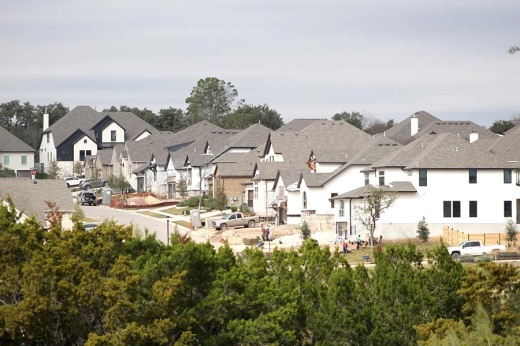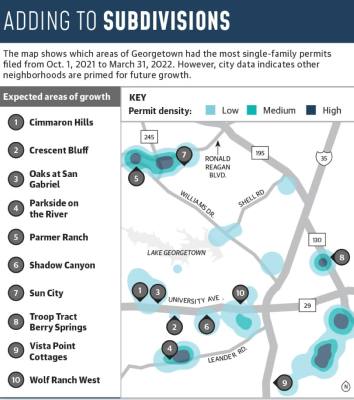With 60 subdivisions under construction and another 27 in the pipeline within Georgetown ISD, the city’s population boom is expected to continue. The U.S. Census Bureau named Georgetown the fastest-growing city in the nation among those with more than 50,000 residents after it grew 10.5% from July 1, 2020, to July 1, 2021, resulting in a population estimate of 75,420.
Using a variety of growth scenarios, the Georgetown Planning Department projects the city’s population could increase to 110,000 by 2030. Local analysts said this will affect Georgetown’s housing market and education and job opportunities.
Mayor Josh Schroeder said in a “complete community,” residents can live, work, go to school and find entertainment.
“Sometimes as communities grow in population size, they can lose one of those attributes if they’re not paying very, very close attention,” he said. “We want to be able to maintain that completeness as a community.”
A place to live
To accommodate the influx of new residents, housing developments are going up throughout the city. Groundwork is underway on 2,200 single-family lots, according to housing market research firm Zonda, and an additional 2,900 multifamily units are being built.
Due to new home construction and a slowdown in the real estate market, Georgetown’s supply of homes increased from 0.5 months of inventory in December 2021 to 3.3 months of inventory in December 2022, according to data from the Austin Board of Realtors.
Bob Templeton, vice president of the school district segment at Zonda, said homebuilders with a stockpile of completed houses and new buyers will start offering incentives and discounts to get them off the market. First, though, a slowdown in home sales is likely to continue.
“Housing normally slows when we get toward the winter months, and then housing typically surges in the spring months as most families try to move over the summer,” he said.
Last summer, U.S. inflation reached a 40-year high at 9.1%. This hit the housing market “like a shockwave,” said Russ Phillips, a Georgetown real estate agent at Russ Phillips Team, as the Federal Reserve raised interest rates higher than many expected.
“From then on, there have been a lot of people sitting on the sidelines waiting to see what happens,” he said.
Home sales dropped after the June inflation report. From then until Dec. 13, active listings on the west side of the city increased by 86%, while pending contracts fell to 35%, according to data collected by Phillips. On the east side, active listings rose 118%, and pending contracts fell 37%. In 2022, closings were down 7.8% year over year, per ABoR data. The decline in home sales is largely attributed to the rise in mortgage interest rates, which often mirrors inflation, according to Phillips.
“This rising interest rate is a tool by the Fed to try to soften inflation, and when that does soften, we will likely see the interest rates coming back down at some point,” he said. “The real question is, ‘When is that going to happen?’”
Between the spring and fall of 2022, interest rates went from 3.5% to 7%, driving the average monthly house payment up to $2,765—an increase of 45.15%, according to Zonda. However, Phillips said the latest action from the Federal Reserve indicates interest rates could start to fall.
After the Federal Reserve raised the rates an additional 0.75% over four consecutive months, in December the hikes were dialed back to an increase of 0.5%. Phillips said industry leaders will pay attention to not only these economic factors influencing the market, but also how the public responds to them. “Right now, sellers are willing to negotiate,” he said. “That may change dramatically if interest rates go back down.”
Bustling business
With homes continuing to be built and sold in the area, Georgetown now has 1 million people living within commuting distance—defined as the area spanning South Austin to Temple—City Manager David Morgan said. This has turned the region into an attractive place for companies looking to expand, helping the city meet a goal of having its residents work where they live.
“That’s a big plus with the traffic congestion and all the different problems that come with rapid growth,” said David Porter, executive director of the Williamson County Economic Development Partnership. “If you get employers to come to your area, to your city, then that means more of your residents can stay in Georgetown to work. So we’re no longer a bedroom community.”
CelLink Corp. and GAF Energy are just two of the companies moving to Georgetown. CelLink—a company that makes wiring systems for electric vehicles and battery packs—leased 294,000 square feet at the Titan Gateway35 Commerce Center. GAF Energy, which specializes in solar roofing, is constructing a 450,000-square-foot manufacturing facility on the southeast corner of I-35 and SE Inner Loop.
In the meantime, city officials said Class A industrial space has grown to 7 million square feet in Georgetown. Cities facing growth often feel pressure to turn industrial sites into residential properties, Porter said.
“One thing that’s really lacking in the United States right now [is] a large number of industrial sites,” he said. “So the cities, counties and states that maintain their industrial sites are going to be ahead of the game.”
City Council continues approving industrial development. In October, council signed off on rezoning 56.73 acres at 2990 N. I-35. Owned by Fidelis, the property will include three buildings with 500,000 square feet of flex office space and a distribution center. For 20 years, the real estate company has owned, developed and managed large-scale shopping centers—a majority of which are in Houston.
Porter said the city is in good shape to continue pursuing similar efforts.
“Some of the cities in Williamson County are landlocked, meaning they just don’t have the land to develop industrial sites, but Georgetown isn’t,” Porter said. “So they have the capability of keeping those sites that are very precious as industrial sites.”
Homegrown workers
More homes, more companies and more available jobs mean more students residing within GISD. Like many Central Texas school districts, GISD is considered a fast-growth district, on pace to reach a student enrollment of more than 20,000 in the next 10 years, up from 13,164 in the 2022-23 school year.
To accommodate for the growth in students, GISD has plans to open three facilities for the 2024-25 school year, including an elementary school, a middle school and a future-ready learning center. Superintendent Fred Brent said the district also expects to have another bond election sometime in 2024 to fund four additional campuses.
As companies decide what areas to move into, Porter said they examine the skilled labor force. GISD is working to address this, too, as Brent said school officials are considering new ways it can help fill those positions, such as through programs offered at the $97 million career and technical education center.
“We’re very interested in pursuing ways that we can accommodate workforce demand through the future-ready complex,” Brent said. “It’s not uncommon for industries to say, ‘We can hire a lot of students right now. We’ll teach them what we want them to know. We just want to know they have some degree of skilled work capacity.’”
City challenges
High population growth places a stress on all parts of city government, Morgan said. The challenge is maintaining core services while doing appropriate planning to guide growth in a positive direction, he said.
As the city grows, Morgan said officials are prioritizing infrastructure expansion, such as road, water utility and electric utility construction along with strategies to pay for these improvements, such as impact fees. As part of the planning process, city officials will rewrite the development code as well as update the water and wastewater master plan, the mobility plan, the comprehensive land use plan and the downtown master plan.
While appealing to big business, city officials also hope to nurture the qualities that lured them and many locals to Georgetown in the first place.
“We are working to maintain the ‘small-town charm’ that residents and visitors value about Georgetown, ” Morgan said. “This includes historic preservation, arts and culture activities, special events and enhancing our river corridors with trails.”
Ramifications of rapid growth
With available land to build, Georgetown's growing population puts pressure on the housing market, schools, economy and infrastructure to keep up.
- Housing: More than 1,600 single-family homes are under construction, and more than 2,900 multifamily units are under construction within Georgetown ISD.
- Students: From the 2018-2019 school year to the 2022-23 school year, the number of students attending Georgetown ISD increased from 11,759 to 13,164. Enrollment projections show the district expects to add more than 3,100 students in the next five years. GISD has three facilities under construction and is considering another bond in 2024.
- Industry and jobs: From 2017-23, Georgetown's work force labor shed—the area from which local employers pull in workers—grew from 700,000 people to 1 million. This area encompasses South Austin to Temple.
- Infrastructure: When a city's population grows, local government leaders must plan to expand services to meet the needs of these new residents, including water capacity and more larger roads. Georgetown is updating plans that outline how the city hopes to grow.







